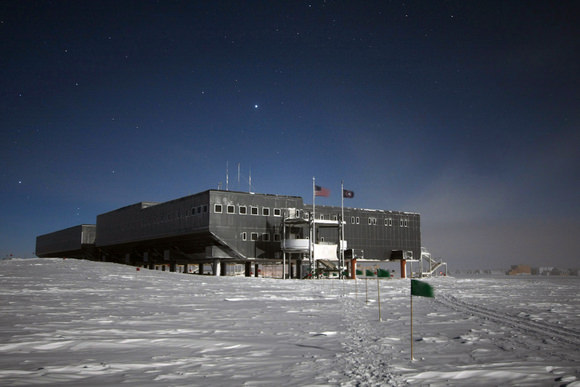[/caption]
I just had to share this gorgeous image of the Aurora Australis over the Amundsen-Scott South Pole Station in Antarctica. “Northerners” like myself occasionally get to see the Aurora Borealis, or Northern Lights, but fewer people get to the the Aurora Australis because so few people live in Antarctica during the austral winter. In both hemispheres however, the cause of these eerie light shows is the same: the solar wind passing through the Earth’s upper atmosphere. This image was taken in May of 2008, but was just recently posted by the National Science Foundation.
Here’s a link to a larger, hi-res version of the image above.
The Amundsen-Scott Station has been open for just a year, and below are more pictures and information.

Stars are visible in this image, also taken in May of 2008, during the short daytime in the winter at the South Pole. Amundsen-Scott South Pole Station sits at the Earth’s axis, atop a constantly shifting continental ice sheet nearly two miles thick. This is perhaps the world’s most remote research facility,
In January 2008, the National Science Foundation (NSF) dedicated the new station at the Pole, the third since 1956. The new station is larger and much more sophisticated than any previous structure built at the Pole. Research in a range of areas, from astrophysics to seismology, takes place at the station. The new elevated station contains dorm rooms, laboratories, office space, cafeteria and recreational facilities.
If you’d like to keep an eye on what’s going at the Station, there is a live web-cam that updates every 20 seconds.
There’s a huge amount of information about Amundsen-Scott Station at the NSF website.
Source: NSF


A small off-top. Could you help me identify what kind of object I’m observing now on the sky? It a strong shining ‘dot’, just like a star but brighter. I’m living in Bialystok, Poland(http://maps.google.com/maps?ll=53.116667,23.166667&spn=0.01,0.01&t=k&q=53.116667,23.166667), and the object is low on the south-west sky(2h before it was quite high on the south). Now it’s 7:30 PM CET. If you need ask me for more infos, I’ll do my best to answer:). And ofc, many thanks in advance for help in solving my little puzzle:P.
After some searching… Maybe it was Venus? Tomorrow it has it’s biggest elongation, so it also has the best circumstanses to be visible from Earth.
In the aurora picture, one can see that Sagittarius is partly visible through the aurora. The “Milk Dipper” is clear of the sky glow and the other end of the constellation is partly visible.